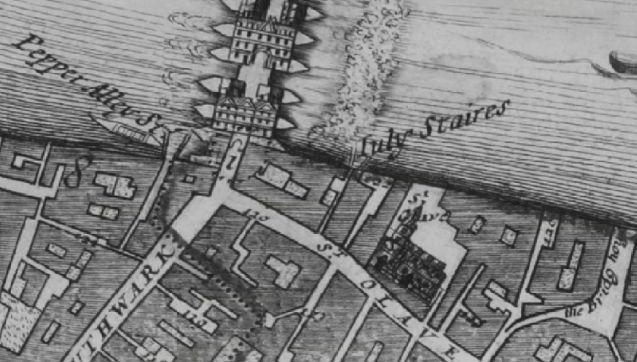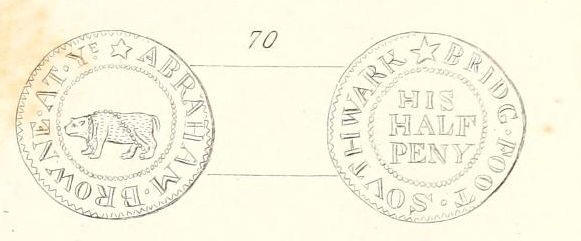

Search london history from Roman times to modern day
Southwark St Olave pub history index

A listing of historical London public houses, Taverns, Inns, Beer Houses and Hotels in Southwark St Olave, Surrey, London.
Residents at this address.
At the south end of London Bridge, and on the west side of it, stood a tavern called the 'Bear at the Bridge Foot.' It was built in the year 1319 by one Thomas Drinkwater, taverner of London. In Riley's 'Memorials' may be found a lease of this house by the proprietor to one James Beauflur. The lease is for six years. James Beauflur is to pay no rent, because he has advanced money to Thomas Drinkwater to help in the building. James is, in fact, to act as manager of a 'tied' house. Thomas Drinkwater will furnish all the wine, and will keep an exact account of the same and will have a settlement twice a year. Thomas will also complete the furniture of the house with 'hanaps,' that is, handled mugs of silver and of wood, with curtains, clothes, and everything else necessary for the proper conduct of a tavern.
This celebrated tavern, situated in Southwark, on the west side of the foot of London Bridge, opposite the end of St. Olave's or Tooley-street, was a house of considerable antiquity. We read in the accounts of the Steward of Sir John Howard, March 6th, 1463-4 (Edward IV.),
The Bear must have been a characterless house, for among its gallantries was the following, told by Wycherley to Major Pack, " just for the oddness of the thing."
It was this : " There was a house at the Bridge Foot where persons of better condition used to resort for pleasure and privacy. The liquor the ladies and their lovers used to drink at these meetings was canary ; and among other compliments the gentlemen paid their mistresses, this it seems was always one, to take hold of the bottom of their smocks, and pouring the wine through that filter, feast their imaginations with the thought of what gave the zesto, and so drink a health to the toast."
This was properly within the city of London, and formed part of Bridge Ward Within, which extended all over the bridge, and included the gate at the south end of the bridge, and some houses on each side of the way, in the parish of Saint Olave, Southwark, as far as the stulpes (wooden posts), which marked the extent of the barrier, or outer fortification of the bridge gate.
Gerrard, in a letter to Lord Strafford, printed among the Strafford Papers, dated January, 1633, intimates that "all back doors to taverns on the Thames are commanded to be shut up, only the Bear at the Bridge-foot is exempted, by reason of the passage to Greenwich." The tavern was situated on the west side, opposite the end of St. Olaves or Tooley street. Query, whether this " passage to Greenwich" was the avenue or way called Bear alley ? See No. 136.
The Cavaliers' Ballad on the funeral pageant of Admiral Deane, killed June 2nd, 1653, while passing by water to Henry the Seventh's Chapel, Westminster, has the following allusion : —
" From Greenwich towards the Bear at Bridge foot,
He was wafted with wind that had water to't,
But I think they brought the devil to boot,
Which nobody can deny."
In another ballad, " On banishing the Ladies out of Town," by the Commonwealth
authorities, the notoriety of the Bear at Bridge-foot is again manifest :
" Farewell Bridge-foot and Bear there-by,
And those bald pates that stand so high ;
We wish it from our very souls
That other heads were on those poles !"
On the 24th March 1660-61 Pepys mentions the Beare, similar to below, i.e. "So home again, and took water with them towards Westminster; but as we put off with the boat Griffin came after me to tell me that Sir G. Carteret and the rest were at the office, so I intended to see them through the bridge and come back again, but the tide being against us, when we were almost through we were carried back again with much danger, and Mrs. Pierce was much afeard and frightened. So I carried them to the other side and walked to the Beare, and sent them away, and so back again myself to the office, but finding nobody there I went again to the Old Swan, and thence by water to the New Exchange ..", and again a brief mention on the 3rd June 1661
"This night going through bridge by water, my waterman told me how the mistress of the Beare tavern, at the bridge-foot, did lately fling herself into the Thames, and drowned herself; which did trouble me the more, when they tell me it was she that did live at the White Horse tavern in Lumbard Streete, which was a most beautiful woman, as most I have seen". - Pepys 21st February 1666-67.
The Bear tavern token in this cabinet, as also several others issued by Southwark traders, now of rare occurrence, were on the demolition of St. Olaves, or Queen Elizabeths Grammar-school, in 1839, found between the joists, below the floorings of the school-room, and purchased from the labourers then employed.
#236 CORNELIUS COOKE AT THE A bear passant, with collar and chain.
Rev. BEARE . AT THE BRIDGE FOT In the field, C. A. C.
Cornelius Cooke was a man of some note in his time; I find him mentioned in the parish accounts of St. Olave's, as overseer of the land side, as early as 1630. He afterwards became a soldier, and was a captain of the trained bands. He rose to the rank of colonel in Cromwell's army, and was appointed one of the commissioners for sale of the king's lands.
After the restoration of King Charles II. he seems to have settled down among his old friends in St. Olave's, as landlord of "The Bear" at the bridge-foot, where he doubtless frequently fought o'er his fields again, and told his tales of the civil wars.

Abraham Browne at the Bear at Bridge-foot, his halfpenny
Morgans map of London in 1682 shows London Bridge, Pepper Alley Stairs and St Olave Street, Southwark.
Vintners in the Mint, with the Debates of a Committee of that Profession, thither fled to avoid the cruel persecution of their unmerciful creditors. A poem. London: printed for E. Hawkins, 1691," 4to.,14 in which "The Bear" is thus mentioned (after landing at Pepper Alley) :—
"Through stinks of all sorts, both the simple and compound,
Which through narrow alleys our senses do confound,
We came to the Bear, which we soon understood
Was the first house in Southwark built after the flood,
And has such a succession of vintners known,
Not more names were e'er in Welsh pedigrees shown:
But claret with them was so much out of fashion,
That it has not been known there a whole generation."
The Bear Tavern was taken down in December, 1761, when the labourers found gold and silver coins, of the time of Elizabeth, to a considerable value. The wall that enclosed the tavern was not cleared away until 1764, when the ground was cleared and levelled quite up to Pepper Alley stairs. There is a Token of the Bear Tavern, in the Beaufoy cabinet, which, with other rare Southwark tokens, was found under the floors in taking down St. Olave's Grammar School in 1839.
Trying to avoid privacy and cookie settings overwriting content